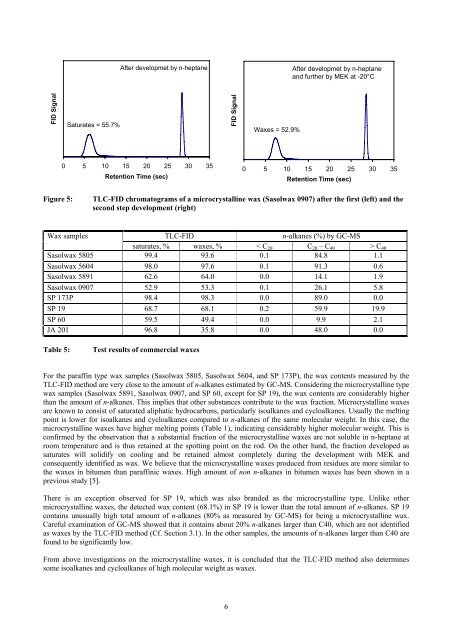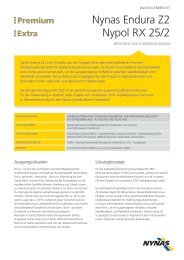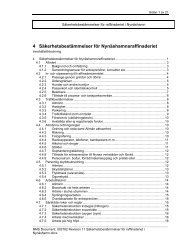A Novel Method for Determination of Paraffin Wax Content ... - Nynas
A Novel Method for Determination of Paraffin Wax Content ... - Nynas
A Novel Method for Determination of Paraffin Wax Content ... - Nynas
You also want an ePaper? Increase the reach of your titles
YUMPU automatically turns print PDFs into web optimized ePapers that Google loves.
FID Signal<br />
Saturates = 55.7%<br />
After developmet by n-heptane<br />
0 5 10 15 20 25 30 35<br />
Retention Time (sec)<br />
FID Signal<br />
<strong>Wax</strong>es = 52.9%<br />
After developmet by n-heptane<br />
and further by MEK at -20°C<br />
0 5 10 15 20 25 30 35<br />
Retention Time (sec)<br />
Figure 5: TLC-FID chromatograms <strong>of</strong> a microcrystalline wax (Sasolwax 0907) after the first (left) and the<br />
second step development (right)<br />
<strong>Wax</strong> samples<br />
TLC-FID n-alkanes (%) by GC-MS<br />
saturates, % waxes, % < C20 C20 – C40 > C40<br />
Sasolwax 5805 99.4 93.6 0.1 84.8 1.1<br />
Sasolwax 5604 98.0 97.6 0.1 91.3 0.6<br />
Sasolwax 5891 62.6 64.0 0.0 14.1 1.9<br />
Sasolwax 0907 52.9 53.3 0.1 26.1 5.8<br />
SP 173P 98.4 98.3 0.0 89.0 0.0<br />
SP 19 68.7 68.1 0.2 59.9 19.9<br />
SP 60 59.5 49.4 0.0 9.9 2.1<br />
JA 201 96.8 35.8 0.0 48.0 0.0<br />
Table 5: Test results <strong>of</strong> commercial waxes<br />
For the paraffin type wax samples (Sasolwax 5805, Sasolwax 5604, and SP 173P), the wax contents measured by the<br />
TLC-FID method are very close to the amount <strong>of</strong> n-alkanes estimated by GC-MS. Considering the microcrystalline type<br />
wax samples (Sasolwax 5891, Sasolwax 0907, and SP 60, except <strong>for</strong> SP 19), the wax contents are considerably higher<br />
than the amount <strong>of</strong> n-alkanes. This implies that other substances contribute to the wax fraction. Microcrystalline waxes<br />
are known to consist <strong>of</strong> saturated aliphatic hydrocarbons, particularly isoalkanes and cycloalkanes. Usually the melting<br />
point is lower <strong>for</strong> isoalkanes and cycloalkanes compared to n-alkanes <strong>of</strong> the same molecular weight. In this case, the<br />
microcrystalline waxes have higher melting points (Table 1), indicating considerably higher molecular weight. This is<br />
confirmed by the observation that a substantial fraction <strong>of</strong> the microcrystalline waxes are not soluble in n-heptane at<br />
room temperature and is thus retained at the spotting point on the rod. On the other hand, the fraction developed as<br />
saturates will solidify on cooling and be retained almost completely during the development with MEK and<br />
consequently identified as wax. We believe that the microcrystalline waxes produced from residues are more similar to<br />
the waxes in bitumen than paraffinic waxes. High amount <strong>of</strong> non n-alkanes in bitumen waxes has been shown in a<br />
previous study [5].<br />
There is an exception observed <strong>for</strong> SP 19, which was also branded as the microcrystalline type. Unlike other<br />
microcrystalline waxes, the detected wax content (68.1%) in SP 19 is lower than the total amount <strong>of</strong> n-alkanes. SP 19<br />
contains unusually high total amount <strong>of</strong> n-alkanes (80% as measured by GC-MS) <strong>for</strong> being a microcrystalline wax.<br />
Careful examination <strong>of</strong> GC-MS showed that it contains about 20% n-alkanes larger than C40, which are not identified<br />
as waxes by the TLC-FID method (Cf. Section 3.1). In the other samples, the amounts <strong>of</strong> n-alkanes larger than C40 are<br />
found to be significantly low.<br />
From above investigations on the microcrystalline waxes, it is concluded that the TLC-FID method also determines<br />
some isoalkanes and cycloalkanes <strong>of</strong> high molecular weight as waxes.<br />
6








![Säkerhetsbestämmelser Gbg rev 5.ppt [Compatibility Mode] - Nynas](https://img.yumpu.com/18742268/1/190x146/sakerhetsbestammelser-gbg-rev-5ppt-compatibility-mode-nynas.jpg?quality=85)







